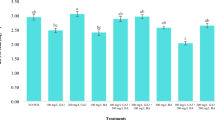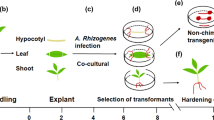Abstract
In most tree-breeding programs worldwide, increasing the trees' growth rates and stem volumes and shortening their rotation times are important aims. Such trees would yield more biomass per unit area. Here we show that overexpressing a key regulatory gene in the biosynthesis of the plant hormone gibberellin (GA) in hybrid aspen (Populus tremula × P. tremuloides) improves growth rate and biomass. In addition, these transgenic trees have more numerous and longer xylem fibers than unmodified wild-type (wt) plants. Long fibers are desirable in the production of strong paper, but it has not as yet proved possible to influence this trait by traditional breeding techniques. We also show that GA has an antagonistic effect on root initiation, as the transgenic lines showed poorer rooting than the control plants when potted in soil. However, the negative effect on rooting efficiencies in the initial establishment of young plantlets in the growth chamber did not significantly affect root growth at later stages.
This is a preview of subscription content, access via your institution
Access options
Subscribe to this journal
Receive 12 print issues and online access
$209.00 per year
only $17.42 per issue
Buy this article
- Purchase on Springer Link
- Instant access to full article PDF
Prices may be subject to local taxes which are calculated during checkout




Similar content being viewed by others

References
Cheliak, W.M. & Rogers, D.L. Integrating biotechnology into tree improvement program. Can. J. For. Res. 20, 452–463 (1990).
Van Doorsselaere, J. et al. A novel lignin in poplar trees with a reduced caffeic acid 5-hydroxyferulic acid o-methyltransferase activity. Plant J. 8, 855–864 (1995).
Hu, W.J. et al. Repression of lignin biosynthesis promotes cellulose accumulation and growth in transgenic trees. Nat. Biotechnol. 17, 808–812 (1999).
Weigel, D. & Nilsson, O. A developmental switch sufficient for flowering initiation in diverse plants. Nature 377, 495–500 (1995).
Wang, G.J. et al. Poplar (Populus nigra L) plants transformed with a Bacillus thuringiensis toxin gene: insecticidal activity and genomic analysis. Transgen. Res. 5, 289–301 (1996).
Fillati, J.-A.J., Sellmer, J., McCown, B., Haissig, B. & Comai, L. Agrobacterium-mediated transformation and regeneration of Populus. Mol. Gen. Genet. 206, 192–199 (1987).
Tuominen, H. et al. Altered growth and wood characterstics in transgenic hybrid aspen expressing the Agrobacterium tumefaciens T-DNA indoleacetic-acid biosynthetic genes. Plant Physiol. 109, 1179–1189 (1995).
Vonschwartzenberg, K., Doumas, P., Jouanin, L. & Pilate, G. Enhancement of the endogenous cytokinin concentration in poplar by transformation with Agrobacterium T-DNA gene ipt. Tree Physiol 14, 27–35 (1994).
Nilsson, O., Moritz, T., Sundberg, B., Sandberg, G. & Olsson, O. Expression of the Agrobacterium rhizogenes rolC gene in a deciduous forest tree alters growth and development and leads to stem fasciation. Plant Physiol 112, 493–502 (1996).
Kende, H. & Zeevaart, J.A.D. The five “classical” plant hormones. Plant Cell 9, 1197–1210 (1997).
Hedden, P. & Proebsting, W.M. Genetic analysis of gibberellin biosynthesis. Plant Physiol. 119, 365–370 (1999).
Hedden, P. & Kamiya, Y. Gibberellin biosynthesis: enzymes, genes and their regulation. Annu. Rev. Plant Physiol. Plant Mol. Biol. 48, 431–460 (1997).
Phillips, A.L. et al. Isolation and expression of three gibberellin 20-oxidase cDNA clones from Arabidopsis. Plant Physiol. 108, 1049–1057 (1995).
Xu, Y.L., Li, L., Gage, D.A. & Zeevaart, J.A.D. Feedback regulation of GA5 expression and metabolic engineering of gibberellin levels in Arabidopsis. Plant Cell 11, 927–935 (1999).
Coles, J.P. et al. Modification of gibberellin production and plant development in Arabidopsis by sense and antisense expression of gibberellin 20-oxidase genes. Plant J. 17, 547–556 (1999).
Digby, J. & Wareing, P.F. The effect of applied growth hormones on cambial division and the differentiation of the cambial derivatives. Ann. Bot. 30, 539–549 (1966).
Wareing, F.B. Interaction between indole-acetic acid and gibberellic in cambial activity. Nature 181, 1744–1745 (1958).
Ridoutt, B.G., Pharis, R.P. & Sands, R. Fiber length and gibberellins A1 and A20 are decreased in Eucalyptus globulus by acylcyclohexanedione injected into the stem. Physiol. Plant. 96, 559–566 (1996).
Little, C.H.A. & Pharis, R.P. In Plant stems: physiology and functional morphology (ed. Gartner, B.L.) 281–319 (Academic Press, San Diego; 1995).
Wang, Q., Little, C.H.A. & Odén, P.C. Effect of laterally applied gibberellin A(4/7) on cambial growth and the level of indole-3-acetic acid in Pinus sylvestris shoots. Physiol. Plant. 95, 187–194 (1995).
Nilsson, O. et al. Spatial pattern of cauliflower mosaic virus 35S promoter-luciferase expression in transgenic hybrid aspen trees monitored by enzymatic assay and non-destructive imaging. Transgen. Res. 1, 209–220 (1992).
Sachs, R.M. Stem elongation. Ann. Rev. Plant Physiol. 16, 73–96 (1965).
Sauter, M., Mekhedov, S.L. & Kende, H. Gibberellin promotes histone H1 kinase activity and the expression of cdc2 and cyclin genes during the induction of rapid growth in deepwater rice internodes. Plant J. 7, 623–632 (1995).
Sauter, M., Seagull, R.W. & Kende, H. Internodal elongation and orientation of celluose microfibrils and microtubles in deep-water rice. Planta 190, 354–362 (1993).
Telewski, F.W., Aloni, A. & Sauter, J.J. In Biology of Populus and its implications for management and conservation, Vol. II (eds Stettler, R.F., Bradshaw, H.D., Heilman, P.E. & Hinckley, T.M.) 301–329 (NRC Research Press, Ottawa; 1996).
Ross, J.J., Murfet, I.C. & Reid, J.B. Distribution of gibberellins in Lathyrus odoratus L. and their role in leaf growth. Planta 102, 603–608 (1993).
Ross, J.J., Murfet, I.C. & Reid, J.B. Gibberellin mutants. Physiol. Plant. 100, 550–560 (1997).
Tsuge, T., Tsukaya, H. & Uchimiya, H. Two independent and polarized processes of cell elongation regulate leaf blade expansion in Arabidopsis thaliana (L.) Heynh. Development 122, 1589–1600 (1996).
Teng, Y.X. & Timmer, V.R. Growth and nutrition of hybrid poplar in response to phosphorus, zinc, and gibberellic-acid treatments. Forest Sci. 39, 252–259 (1993).
Kozlowski, T.T. & Pallardy, S.G. Growth control in woody plants (Academic Press, San Diego; 1997).
Smith, D.R. & Thorpe, T.A. Root initiation in cuttings of Pinus radiata seedlings. II. Growth regulator interactions. J. Exp. Bot. 26, 193–202 (1975).
Vieira, J. & Messing, J. New pUC-derived cloning vectors with different selectable markers and DNA replication origins. Gene 100, 189–194 (1991).
Walden, R., Koncz, C. & Schell, J. The use of gene vectors in plant molecular biology. Methods Mol. Cell Biol. 1, 175–194 (1990).
Murashige, T. & Skoog, F. A revised medium for rapid growth and bio-assay with tobacco tissue cultures. Physiol. Plant. 15, 473–479 (1962).
Regan, S., Bourquin, V., Tuominen, H. & Sundberg, B. Accurate and high resolution in situ hybridization analysis of gene expression in secondary stem tissues. Plant J. 19, 363–369 (1999).
Chang, S., Puryear, J. & Cairney, J. A simple and efficient method for isolating RNA from pine trees. Plant Mol. Biol. Rep. 11, 113–116 (1993).
Sambrook, J., Fritsch, E. & Maniatis, T. Molecular cloning: a laboratory manual. (Cold Spring Harbor Laboratory Press, Cold Spring Harbor, NY; 1989).
Sterky, F. et al. Gene discovery in the wood-forming tissues of poplar: analysis of 5,692 expressed sequence tags. Proc. Natl. Acad. Sci. USA 95, 13330–13335 (1998).
Church, G.M. & Gilbert, W. Genomic sequencing. Proc. Natl. Acad. Sci. USA 81, 1991–1995 (1984).
Peng, J.R., Richards, D.E., Moritz, T., CanoDelgado, A. & Harberd, N.P. Extragenic suppressors of the Arabidopsis gai mutation alter the dose–response relationship of diverse gibberellin responses. Plant Physiol. 119, 1199–1207 (1999).
Acknowledgements
Thanks are due to Peter Hedden for the pAt2301 construct, Göran Sandberg and Björn Sundberg for helpful discussions, and Ingabritt Carlsson, Leif Lund, and Marie Nygren for technical assistance. The Swedish Natural Science Research Council (NFR), The Swedish Research Council for Agriculture Sciences (SJFR), Foundation for Strategic Research (SSF), and Jakob Wallenberg-Lars Erik Thunholms Stiftelse are acknowledged for financial support.
Author information
Authors and Affiliations
Corresponding author
Rights and permissions
About this article
Cite this article
Eriksson, M., Israelsson, M., Olsson, O. et al. Increased gibberellin biosynthesis in transgenic trees promotes growth, biomass production and xylem fiber length. Nat Biotechnol 18, 784–788 (2000). https://doi.org/10.1038/77355
Received:
Accepted:
Issue Date:
DOI: https://doi.org/10.1038/77355
This article is cited by
-
Investigation of optimal in vitro and ex vitro conditions for the development of Athyrium acutipinnulum Kodama synthetic seed technology
Horticulture, Environment, and Biotechnology (2024)
-
Ectopic expression of Camellia oleifera Abel. gibberellin 20-oxidase gene increased plant height and promoted secondary cell walls deposition in Arabidopsis
Planta (2023)
-
Enhanced metabolic flux of methylerythritol phosphate (MEP) pathway by overexpression of Ginkgo biloba 1-Hydroxy-2-methyl-2-(E)-butenyl 4-diphosphate Reductase 1 (GbHDR1) gene in poplar
Applied Biological Chemistry (2022)
-
Xylem-specific Overexpression of the GIBBERELLIN ACID 20 OXIDASE Gene (GA20-OXIDASE) from Pine in Hybrid Poplar (Populus tremula L. × P. alba L.) Revealed Reliable Increase in Growth and Biomass Production Just in a Single-copy-line
Gesunde Pflanzen (2022)
-
Enhancing plant growth and biomass production by overexpression of GA20ox gene under control of a root preferential promoter
Transgenic Research (2022)


